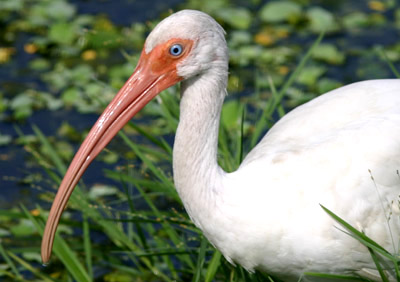Florida, land of limpkins, oasis of anhingas, gathering place of gallinules, offers some of the most distinctive birding in the United States. Not only is the Sunshine State home to an abundance of egrets and herons unheard of in northern climes but it also dangles the promise of potential Caribbean and subtropical species.
So why was I so apprehensive about my impending business trip to Palm Beach? Because while a brief visit would most likely turn up at least a few of these…

White Ibis
…the views wouldn’t be nearly as good as from a dedicated excursion to the Everglades, like the one where I took the photo above. Thankfully, my fears were entirely unfounded.
I flew into Palm Beach, one of the most airy, efficient airports I’ve ever visited, at about 6:00 PM on Wed. night. Since I was leaving right after my conference the following day, the hours between touchdown and sundown represented my only opportunity to observe avifauna. Compounding the challenge was a lack of transportation; my hotel, a mere 1/4 mile away, offered a free shuttle, so no car was warranted. Hence, I had about an hour at my hotel to add exotic (to me) species to the year list. But what an hour!
How was I to know that the Hilton Palm Beach Airport boasts, along with its comfortable beds and free wireless access, a spacious deck overlooking a quintessential Floridian waterway. Where there’s water, there’s waders so it was a matter of moments before I spotted egrets both Great and Snowy as well as a Great Blue Heron enjoying a zen moment beneath a palm tree. The most common herons were without a doubt Tricolored, flying down the channel with white breasts flashing, but some darker Little Blue Herons also passed through. White Ibises were the reason I brought binoculars in the first place and these radiant waders did not disappoint. Anhinga were also accomodating, as if there was any danger of striking out on snakeheads in this part of the state!
The waterway was devoid of ducks, sparing me the angst of discriminating Mottled Ducks from Mallards. Instead, I could enjoy the crimson-tipped Common Moorhen gliding through a carpet of water lilies. Unfortunately, no Purple Gallinules, the moorhen’s more flamboyant kin made the scene. What did turn up and turn up big were Limpkins. The hotel grounds were home to no fewer than four limpkins, chocolate brown cousins to cranes decorated with dagger-sharp white triangles. Not only have I never seen this many limpkins, but I’ve never been as close. One savvy forager, clearly aware that I left my camera in New York, sidled up within 10 feet of my jaw, which had of course dropped with shock. Who doesn’t love a limpkin?
While I mostly had eyes for water birds, I did take time to appreciate the Common and Boat-tailed Grackles as well as the entirely expected Northern Mockingbirds; apparently even Florida is north as far as these mimids are concerned. Stocky Eurasian Collared Doves, with their prominent fan tails and persistent hooting, were a pleasant change of pace from the ubiquitous endemic Mouring Doves, but exemplified how few surprises could be found in the skies above. Yet, if you keep your eyes open, something unexpected usually comes along, in this case a pair of Common Nighthawks. These sharp-winged nightjars resembled falcons at first; instead of adopting their typical sloppy circular flight pattern, they struck a path straight and true into the setting sun.













Hi Mike – you saw quite a few birds there in Palm Beach. That’s great. I would love to add a white ibis (and others) to my life list. I’ll be vacationing the mid-Atlantic area in late August. Any chance I would see any white ibis in Virginia or New Jersey or anywhere in between?
Birds are about the only reason that I would go to Florida(I’m a cold weather and woods type of guy).-It seems to be a great place to do some birding though.
Mary, I did once spot an immature White Ibis at Chincoteague NWR, but that was considered a rarity. You’d have to travel further south to improve your odds of an ibis encounter. One day in Florida will give you all the White Ibis you could want!
Mike – I am trying to figure out what kind of bird is always hooting where I just moved (Skylake area in North Miami Beach). It sounds like Whoo hoo, and it is persistent, day and night. Thank you.